Part 1: Behind the scenes of a complex and collaborative installation process
Multimedia artwork ‘Stargazing’ (2022) was the centrepiece of the Library’s popular exhibition Handmade Universe, on display in Victoria Gallery from 23 June 2022 to 26 February 2023. The exhibition celebrated the power of creativity, the possibilities of craft for teaching us about the world, and the stories of women and their often overlooked but innovative contributions to the artistic and scientific fields.

Left: Aerial view of ‘Stargazing’ during install. Image credit: Adam Meredith.
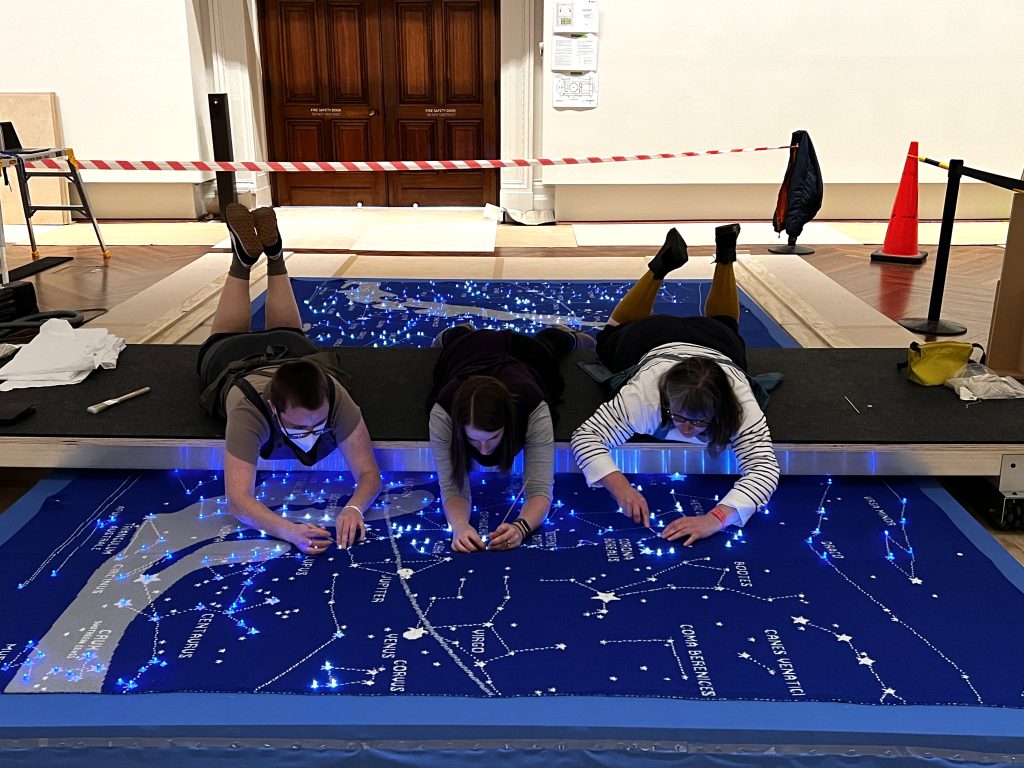
Install team at work on a moveable gantry. Image credit: Jessye Wdowin-McGregor.
The installation process required for this extraordinary artwork is detailed in Part 1 of this blog. Part 2 will feature its deinstallation, a preventive conservation treatment that was undertaken after eight months on display, and considerations for its ongoing care and future access. The blog also highlights the mighty collaborative efforts of a team of staff from across the Library, including Collection Care, Audience Engagement, Collection Curation and Engagement, and Collection Development and Description.
‘Stargazing’ can be described as a time-based media artwork, which means it has a durational dimension – unfolding to an audience over a period of time – and relies on technology to be experienced. These types of artworks are particularly challenging to collect, exhibit and preserve, requiring both physical and digital conservation expertise, and the ability to manage rapid technological obsolescence.
Hacking a knitting machine to weave a universe
Created by artist and software engineer Sarah Spencer, ‘Stargazing’ is a large jacquard knitted equatorial star map, measuring 2.7m x 4.5m. Featuring all 88 constellations in Western astronomy across the Northern and Southern hemispheres, it includes the Milky Way, the sun, the Earth’s moon, and the planets within our solar system. Made by hacking into a 1980’s domestic knitting machine and developing a new computer algorithm, the artist created the knitted component of the map using Australian wool from the Bendigo Woollen Mills.
As a woman in tech, the artist was inspired to make the star map to engage more young minds in STEM (science, technology, engineering, mathematics). She initially received sponsorship to create the map for presentation at Electromagnetic Field in 2018, a camping festival for hackers, artists, crafters, scientists, and engineers in the UK. Then, entering ‘Stargazing’ into REAio, a hackathon in Melbourne, the artist lit up eight of the map’s constellations with a team of 18 hackers, an achievement that won her the Marvin Award for Technical Excellence. This experiment led to the map in its current form, wired and fitted with over 800 LED lights and with the inclusion of coded software that controls the digital interface to light the constellations, designed to be activated by viewers.
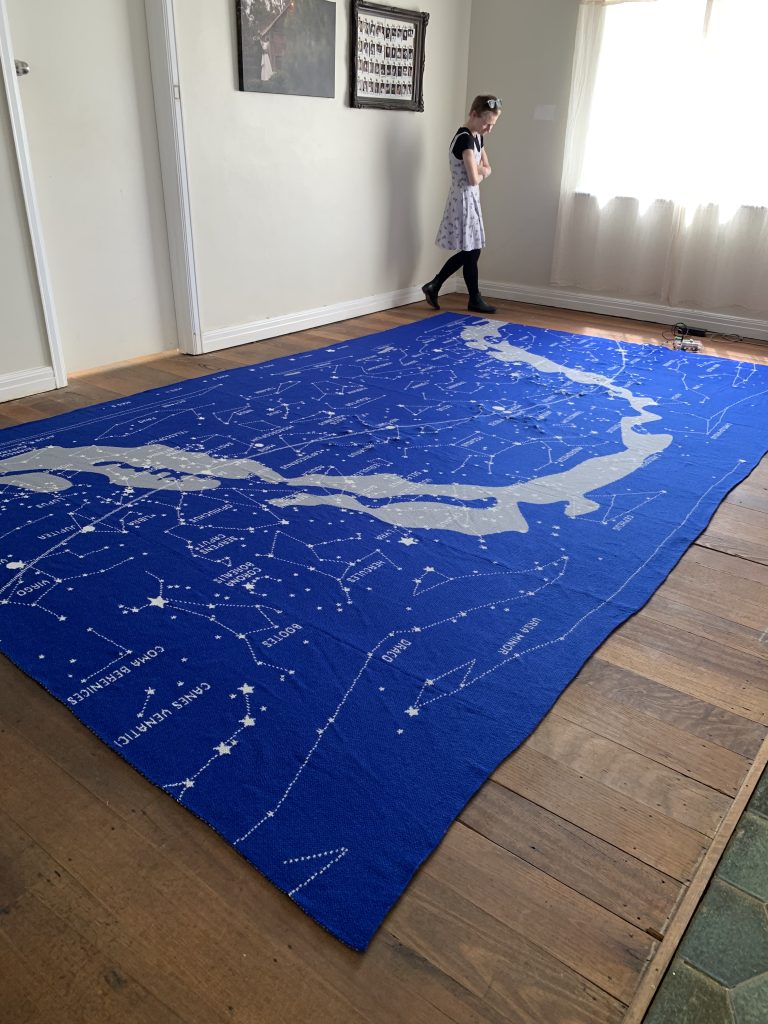
Senior Librarian Sarah Ryan views the knitted layer of ‘Stargazing’ on the floor of artist Sarah Spencer’s home during a site visit. Image credit: Jane Hinwood.
An artwork of many layers
A complex object, constructed of three separate layers (the knitted woollen map, an underlay with LED wiring, and an interleaving fabric – plus the inclusion of electronic hardware), ‘Stargazing’ required careful consideration and planning for its exhibition display, its physical and digital conservation, and upon deinstallation its preparation for long-term storage. In addition, the presence of an app designed by the artist, which enables the interactive part of the map and lights up the constellations, is a type of born-digital item that is new to the Library collection.
The physical components of ‘Stargazing’ came to the Library in two parts: the knitted map itself and the underlay with LED wiring, which sits directly beneath the map. The underlay was the first piece to be prepared for display and was carefully unrolled and secured atop a wooden strainer support frame, designed to keep the artwork relatively taut and enable it to be lifted into a large custom built exhibition mount. A wooden frame, rather than metal, also ensured there was no interference with the electrical wiring.
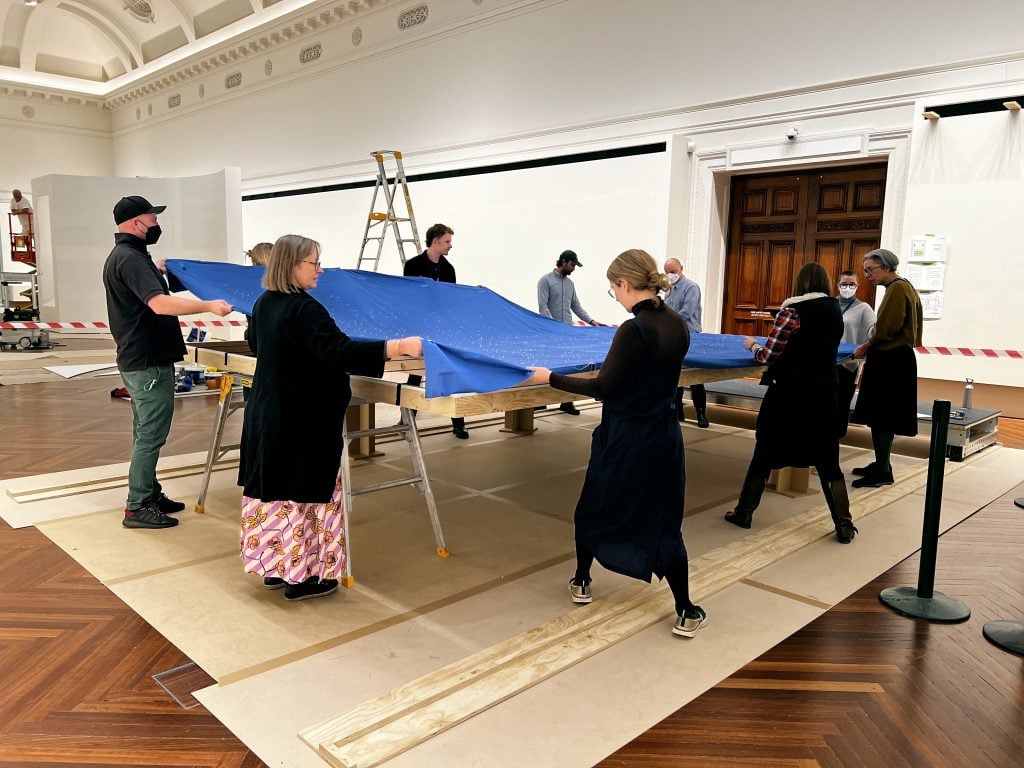
Members of the install team collectively lifting and aligning the underlay with LED wiring onto the wooden strainer support frame. Image credit: Jessye Wdowin-McGregor.

Sarah Spencer checks the wiring from the underside. Image credit: Jessye Wdowin-McGregor.
A temporary hitch
Next, the knitted map was lowered onto the underlay. After a demonstration by Sarah using a small-scale prototype of ‘Stargazing’, work began on gently parting the woollen threads of the knitted map (using tools like wooden skewers and sewing needles) to allow small light wells attached to the underlay to be pushed through. A moveable gantry allowed the installation team to safely access difficult to reach centre areas of the map during this process. However, it became apparent that a component of the artwork was at risk of damage during this process, so a revised approach was required.


Close up view: parting woollen threads to allow the light wells to push through. Image credit: Jessye Wdowin-McGregor.
A particularly vulnerable physical element of the artwork is the light wells, thin rods of clear acrylic which are adhered onto the LED lights attached to the reverse side of the underlay, through the hole of a small metal eyelet. The artist anticipated that some light wells may become dislodged during the rolling of the underlay, and a small number did require reattaching. However, the thin surface area of the bond between the light wells and the LED lights became more apparent during the process of overlaying the knitted map. Despite rigorous testing by the artist on a ‘Stargazing’ prototype, it is possible the 15kg weight of the knitted map may have caused many of the light wells to detach.
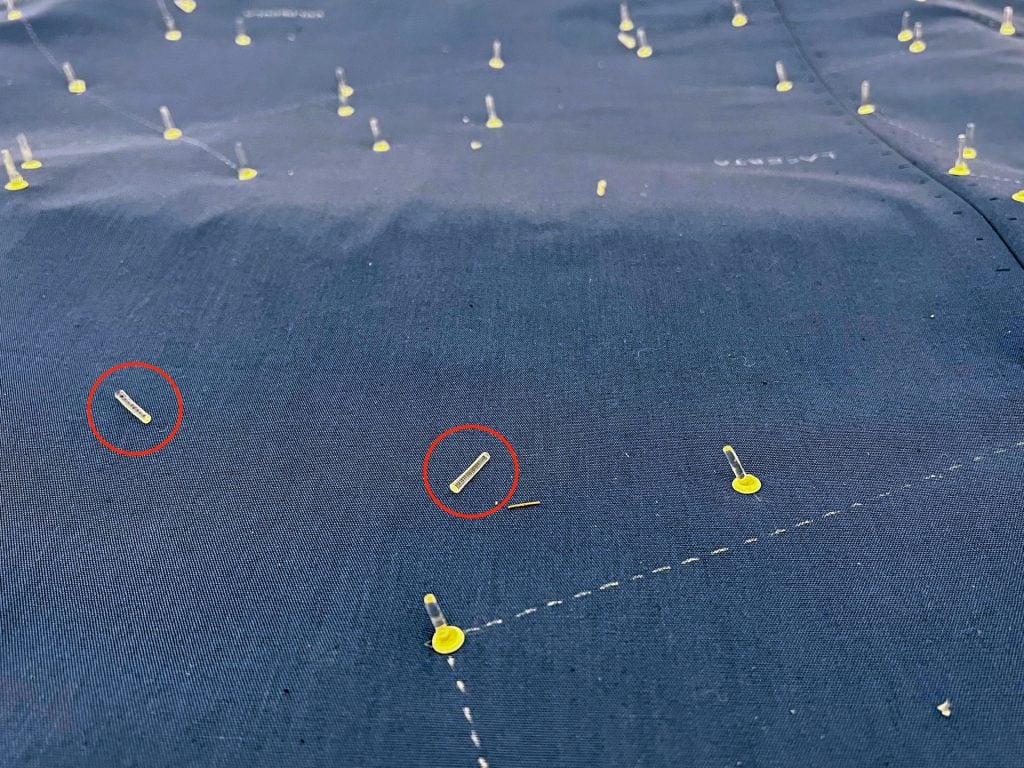
Close up view of dislodged light wells on the underlay. Image credit: Jessye Wdowin-McGregor.
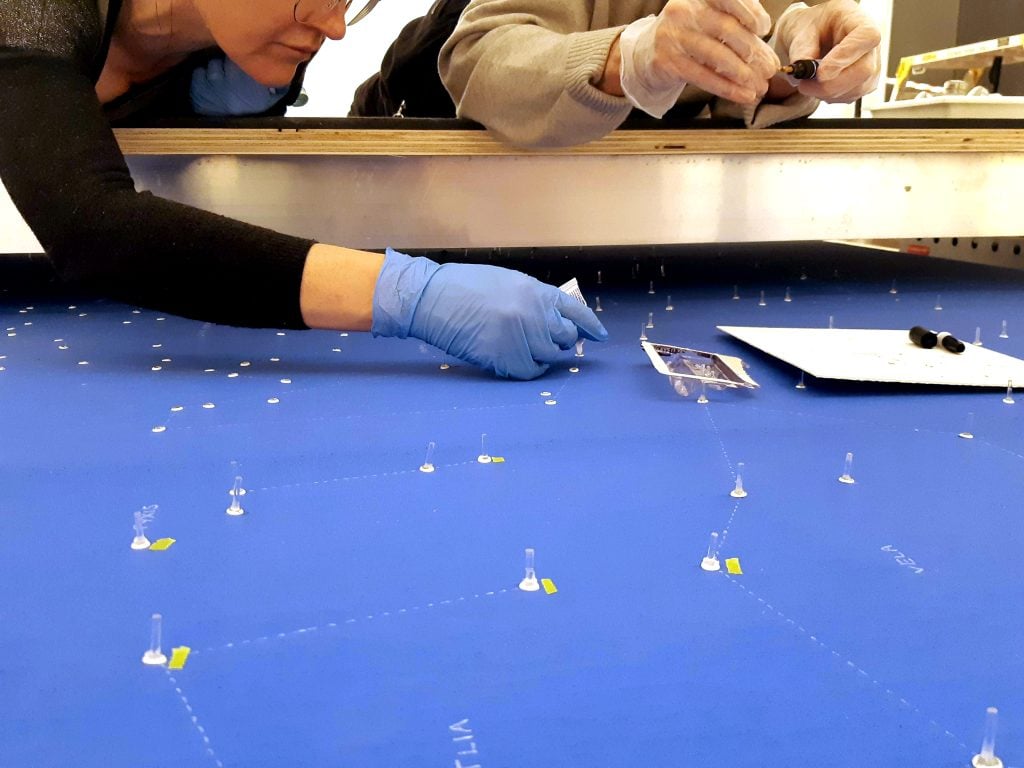
Re-adhering detached light wells on the underlay. Image credit: Emily Keppel.
Under tight time pressures with the exhibition launch looming, staff tested of a series of alternate adhesives on a small section of the underlay, in close consultation with the artist. Out of five tested, a two-part epoxy glue was found to successfully hold the light wells in place and had a relatively quick drying and curing time. Any loose light wells likely to detach were removed before work commenced on adhering all detached light wells across the underlay. The knitted map was then carefully lowered in sections onto the underlay, and work resumed on pushing the light wells through its woollen threads. Once this stage was complete, four strips of interleaving fabric were positioned along the edges between the knitted map and the underlay, and all three layers were sewn together by hand.
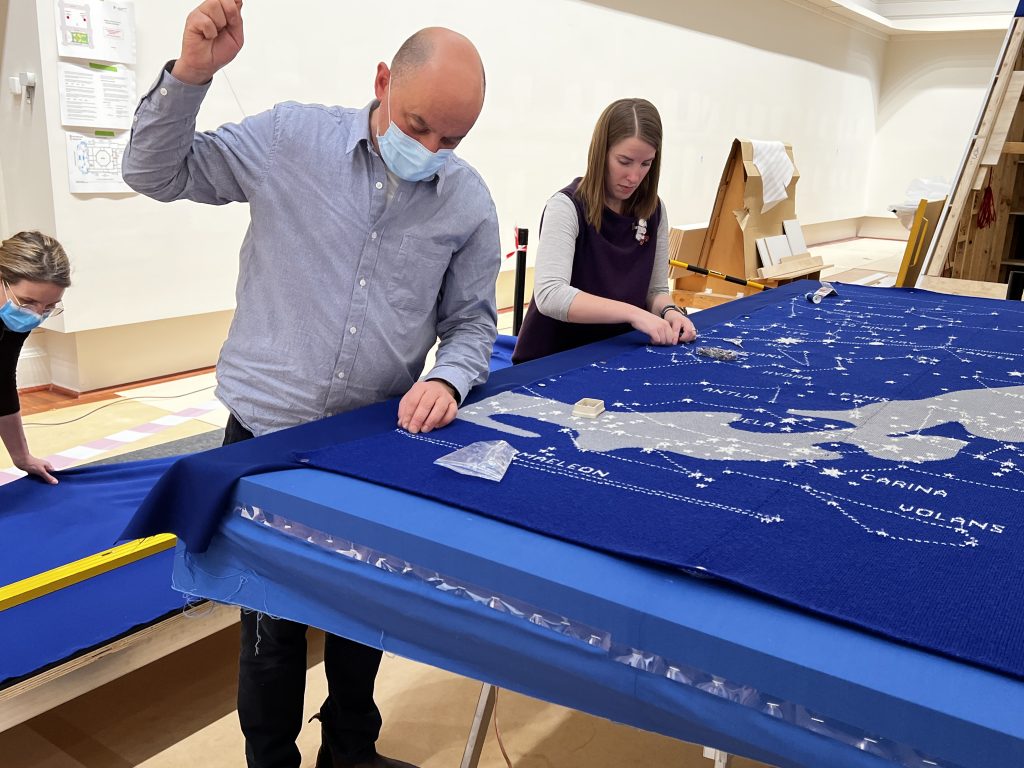
Sewing the underlay, interleaving and knitted layers together. Image credit: Jessye Wdowin-McGregor.

Many hands at work, stitching along all four edges of the artwork. Image credit: Jessye Wdowin-McGregor.
Lighting up the stars
With its three layers combined, ‘Stargazing’ was manoeuvred into a large exhibition mount covered in the same fabric as the interleaving layer, so that the borders of the artwork blended seamlessly into the surrounding blue. A void at the back of the mount provided access for the artist to connect the wiring to the devices that activate and light up the constellations. It also meant that if any issues were to arise with the circuitry or failure of LEDs during the relatively long exhibition period, repairs and troubleshooting could take place.

‘Stargazing’ is collectively manouvered into the exhibition mount. Image credit: Jessye Wdowin-McGregor.
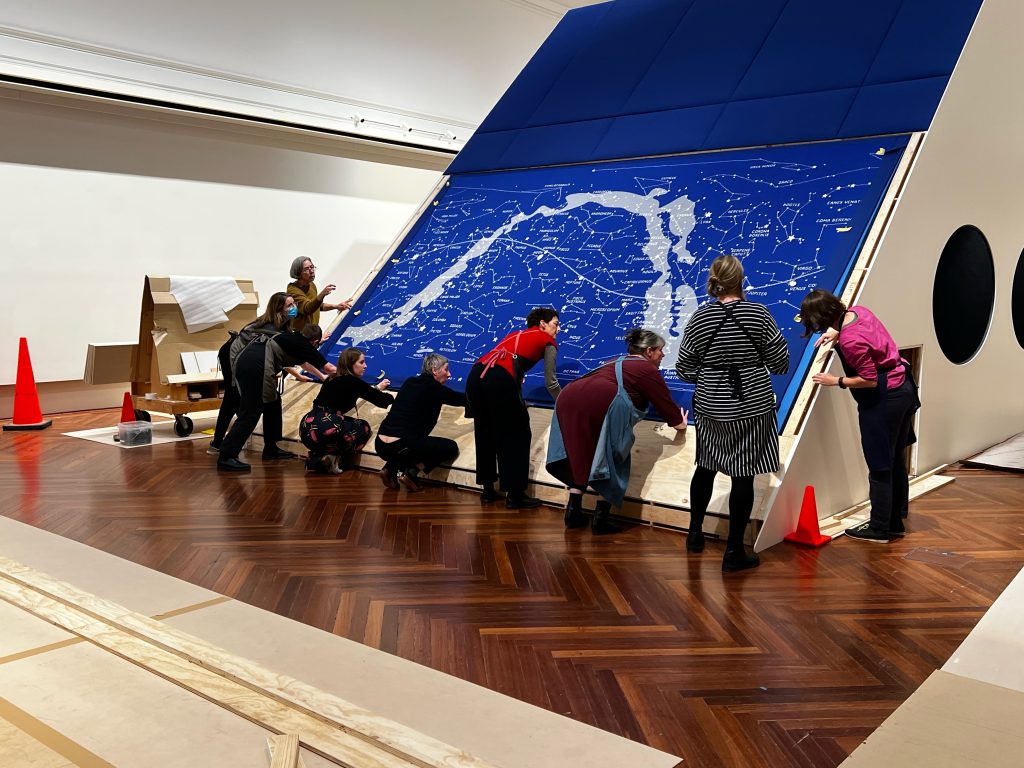
Checking to see the artwork is correctly aligned in the exhibition mount. Image credit: Jessye Wdowin-McGregor.
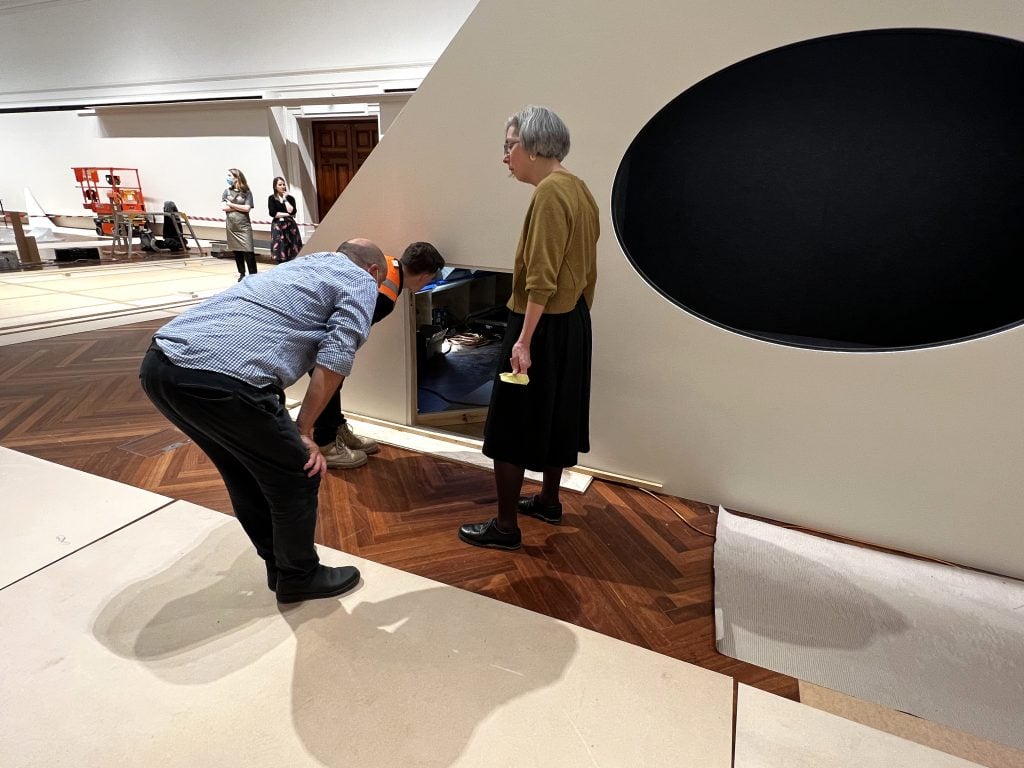
Looking through the doorway to the void at the back of the exhibition mount, where the underside of the artwork and LED wiring is accessible. Image credit: Jessye Wdowin-McGregor.
Keep an eye out for Part 2 which will highlight some of the challenges of safely storing this large and multifaceted artwork once it was removed from display, and considerations for managing the immaterial aspects of ‘Stargazing’.


What an amazing piece and amazing collective effort to restore it. So many different skills
Thank you Fiona, it certainly is an extraordinary artwork! It was a special thing to see so many hands and skillsets at work as part of displaying ‘Stargazing’.
Thanks so much for this I saw it and was astonished by its size, intricacy and beauty.
As a long time knitter and crafts person I’ve done some large pieces but this was and is awesome
Anne Learmonth
Thank you Margaret, it is indeed such a wondrous artwork! Collaboration and collective effort were very much embedded in the work coming to life and the artist’s thinking.